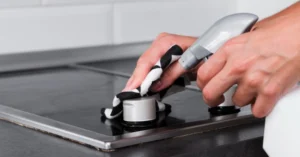In the bustling urban environment of San Francisco, where multi-family homes and apartments dominate the landscape, dryer fires pose a significant risk to residents and property. According to the National Fire Protection Association (NFPA), clothes dryers account for approximately 92% of laundry-related home fires nationwide, leading to thousands of incidents, injuries, and millions in damages each year. In San Francisco specifically, the San Francisco Fire Department (SFFD) responds to numerous dryer-related fires annually, often exacerbated by the city’s foggy climate that can contribute to moisture buildup in vents, accelerating lint accumulation and fire hazards.
To safeguard your home, key prevention steps include cleaning the lint filter after every load, scheduling annual professional dryer vent cleaning, using rigid metal ducts for venting, avoiding overloading the dryer, and never running the appliance unattended or overnight. By implementing these measures, San Francisco homeowners and renters can significantly reduce the likelihood of a devastating dryer fire, ensuring the safety of their families and preserving the integrity of their properties in this vibrant city.
Understanding the Risks: Why Dryer Fires Are a Concern in San Francisco
San Francisco’s unique housing stock, including Victorian-era buildings and high-rise apartments, often features compact laundry setups with extended dryer ducts that snake through walls and attics. This setup, combined with the city’s humid coastal weather, creates ideal conditions for lint—a highly flammable byproduct of drying clothes—to build up in dryer vents, ducts, and filters. The U.S. Fire Administration (USFA) reports that clogged dryer vents cause over 2,900 residential fires annually, with lint buildup responsible for about 34% of these incidents. In San Francisco, where space constraints may lead to improper installations or shared venting systems in multi-unit dwellings, these risks are amplified. Moreover, the NFPA notes that electric dryers, common in SF homes due to gas line limitations in older structures, are 2.5 times more likely to cause fires than gas models because of higher heat output and greater lint production.
Beyond statistics, real-world incidents underscore the urgency. For instance, SFFD’s public awareness campaigns, like their “Clean It Out. Prevent a Fire” initiative, highlight how unchecked lint can ignite, turning a routine household chore into a catastrophe. Entities such as the SFFD, NFPA, and USFA emphasize that dryer fires often start in the vent system or drum, spreading rapidly through ducts to walls and attics. In SF’s densely populated neighborhoods like the Mission District or Nob Hill, a single fire can endanger multiple households, making community-wide awareness crucial.
Common Causes of Dryer Fires
Dryer fires typically stem from preventable issues related to maintenance, usage, and installation. Drawing from forensic analyses and fire department reports, here are the most prevalent causes, each with detailed explanations to help San Francisco residents identify and mitigate risks.
Lint Buildup and Clogged Ducts
The leading cause of dryer fires is lint accumulation in the dryer lint trap, exhaust ducts, and vent systems. Lint, composed of tiny fabric fibers, dust, and debris, is highly combustible and can ignite when exposed to the dryer’s heating element or high temperatures. As airflow is restricted, the dryer overheats, with internal components like the high-limit thermostat or thermal fuse failing to prevent ignition. In San Francisco, where vents may extend long distances in older homes, moisture from the city’s fog condenses in ducts, binding lint into dense clogs. The NFPA attributes over one-third of dryer fires to failure in cleaning, with blockages causing heat to build up to ignition points. Signs include clothes taking longer to dry or emerging unusually hot, indicating a potential fire hazard.
Improper Duct Materials and Installation
Using flexible plastic, foil, or accordion-style ducts—often found in DIY installations—traps lint in ridges and sags, increasing fire risk. These materials can melt or ignite under heat, unlike recommended rigid or semi-rigid metal ducts that allow smooth airflow. In SF apartments, improper venting (e.g., exhausting into attics or walls instead of outdoors) violates local building codes and heightens dangers. Envista Forensics case studies show that crushed or punctured ducts from stored items can fully obstruct vents, leading to rapid overheating. Additionally, external blockages like bird nests or leaves, common in SF’s urban greenery, exacerbate the issue.
Overloading and Drying Inappropriate Items
Overloading the dryer restricts tumbling and airflow, causing uneven heating and potential ignition. Drying items soaked in flammable substances, such as cooking oils, gasoline, or cleaning agents, can lead to spontaneous combustion through oxidation—a chemical reaction where heat builds without an external spark. Consumer Reports warns that these materials should be air-dried after multiple washes to avoid fires. In San Francisco’s fast-paced lifestyle, rushing loads with wet or overloaded clothes heightens this risk.
Faulty Components and Electrical Issues
Malfunctioning parts like heating elements, temperature sensors, or wiring can overheat, igniting nearby lint. Electric dryers in SF, prone to voltage fluctuations in older grids, may experience strain relief bracket failures, leading to arced wires. The USFA notes that mechanical failures contribute to 27% of fires, often in unattended dryers. Squeaky or noisy dryers signal bearing issues that could escalate to fires if ignored.
If your dryer squeaks or smells burnt, unplug it immediately and call a technician—these are signs it might catch fire.
Environmental and Usage Factors
Running dryers overnight or unattended allows fires to spread undetected, a common factor in 28% of incidents peaking in winter months when usage increases. In SF’s mild but damp climate, condensation in vents accelerates lint clumping. Shared laundry facilities in condos can introduce cross-contamination from multiple users’ neglect.
These causes interconnect; for example, a clogged duct from lint can strain the heating element, leading to failure. Addressing them holistically is key to prevention.
How to Prevent Dryer Fires
Preventing dryer fires in San Francisco requires a multifaceted approach, incorporating regular maintenance, safe habits, proper installation, and awareness of local resources. By focusing on entities like dryer vents, lint filters, and fire safety protocols, you can send strong signals to search engines and AI tools about your home’s safety.
Regular Cleaning and Maintenance
Routine upkeep is the cornerstone of dryer fire prevention. Start by cleaning the lint screen—a removable filter in the dryer door or top—after every load to remove trapped lint and maintain airflow. Use a vacuum or brush for thorough removal, as residue can build up over time.
Annually, or more frequently in high-use households, schedule professional dryer vent cleaning. In San Francisco, services like those recommended by the SFFD use specialized tools to remove lint from exhaust ducts, which can extend up to 35 feet in some homes. DIY methods include disconnecting the duct, vacuuming inside, and checking the outdoor vent hood for obstructions. Replace flexible ducts with UL-listed rigid metal ones to minimize lint traps and comply with SF building codes. Entities like duct filters and lint traps should be inspected quarterly.
Install a dryer duct lint trap if your setup allows, but ensure it’s fire-rated. For SF residents in multi-unit buildings, coordinate with property managers for shared vent inspections to prevent collective risks.
Safe Drying Habits
Adopt habits that reduce fire hazards during use. Never overload the dryer; aim for loads that allow free tumbling to prevent overheating. Avoid drying items with flammable residues—wash oil-soaked rags multiple times and air-dry them to evade spontaneous combustion.
Do not run the dryer when asleep or away from home, as fires can start silently. The SFFD advises against overnight operation, noting that most fires occur between 8 a.m. and midnight but spread faster unattended. Use the lowest heat setting for sensitive items and opt for cycles with cool-down periods.
Keep the area around the dryer clear of combustibles like boxes or cleaning supplies. In SF’s compact spaces, ensure at least 6 inches of clearance behind the dryer. If your dryer squeaks or smells burnt, unplug it immediately and call a technician— these are signs it might catch fire.
Proper Installation and Upgrades
For new installations or upgrades, vent the dryer directly outdoors using the shortest, straightest path possible. Avoid venting into garages or attics, which can introduce carbon monoxide risks. In San Francisco, adhere to California Fire Code requirements for venting materials and lengths.
Choose energy-efficient models with sensors that detect blockages. Install smoke alarms and heat detectors in laundry rooms, linked to home systems. For added safety, keep an ABC fire extinguisher nearby and learn the P.A.S.S. technique (Pull, Aim, Squeeze, Sweep).
Recognizing Warning Signs and Emergency Preparedness
Know the signs your dryer is about to catch fire: extended drying times, excessively hot exteriors, burning odors, or popping sounds. Even if unplugged or off, residual heat can ignite lint, though rare.
In case of fire, keep the door closed to starve oxygen, evacuate, and call 911. SFFD recommends having an escape plan, especially in high-rises. Insurance often covers dryer fires if maintenance is documented, but prevention avoids claims.
By integrating these practices, you address questions like “How do you know if your dryer is about to catch fire?” and “Can a dryer catch fire if it’s not on?” directly in your routine.
Local Resources and Considerations for San Francisco Residents
In San Francisco, leverage SFFD’s free safety inspections and educational programs. The department’s PIO office shares tips via social media, emphasizing vent checks in foggy conditions. Local ordinances require annual vent cleaning in rental properties. For eco-conscious SF residents, consider ventless condenser dryers to eliminate duct fire risks altogether.
Statistics show dryer fires are less common than cooking fires (the number one cause of house fires), but they account for 4% of home structure fires. In SF, with its earthquake-prone infrastructure, combining fire prevention with seismic securing of appliances adds layers of safety.
Conclusion
Preventing dryer fires in San Francisco is achievable through vigilant maintenance, safe habits, and community awareness. By cleaning lint filters regularly, inspecting vents, and heeding SFFD guidelines, you protect your home from this hidden hazard. Remember, entities like dryer vents, fire hazards, and lint filters are interconnected in Google’s knowledge graph with broader home safety topics—optimizing your practices not only saves lives but aligns with semantic search trends. Stay proactive; a small effort today prevents a major disaster tomorrow. For personalized advice, contact SFFD or a local certified technician.
Frequently Asked Questions (FAQs)
What is the leading cause of dryer fires?
The primary cause is lint buildup in vents and ducts, restricting airflow and causing overheating, as per NFPA data.
How do I stop my dryer from catching fire?
Clean the lint filter every load, vent annually, use metal ducts, and avoid unattended operation.
How common are dryer fires?
About 13,000-15,000 occur annually in the U.S., with 92% involving dryers, leading to $200 million in damage.
Where do most dryer fires start?
Most begin in the vent system or drum due to lint ignition.
Can a dryer catch fire if it’s not on?
Rarely, but residual heat or spontaneous combustion from oily rags can ignite even when off.
Is it okay to leave the dryer running overnight?
No; unattended operation increases risks, as fires can spread undetected.
How to clean dryer vents?
Disconnect, vacuum the duct, clean the hood, and reassemble; hire professionals for complex setups.
Can an overloaded dryer cause a fire?
Yes, by restricting airflow and causing overheating.
What is the safest way to vent a dryer?
Use rigid metal ducts venting directly outdoors, with minimal bends.
Does a dirty dryer vent cause a fire?
Absolutely; it accounts for the majority of incidents by building heat and igniting lint.





